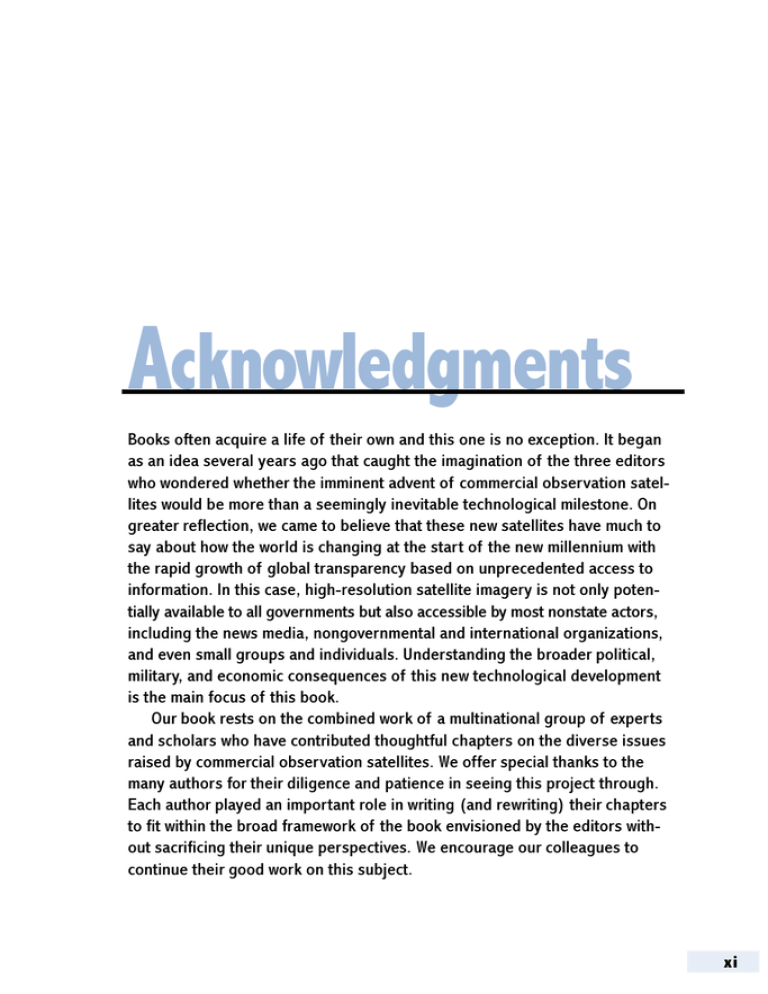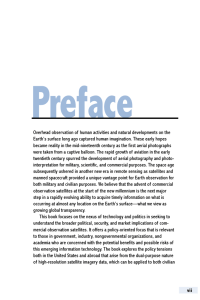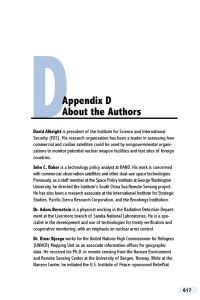A cknowledgments
advertisement

Acknowledgments Books often acquire a life of their own and this one is no exception. It began as an idea several years ago that caught the imagination of the three editors who wondered whether the imminent advent of commercial observation satellites would be more than a seemingly inevitable technological milestone. On greater reflection, we came to believe that these new satellites have much to say about how the world is changing at the start of the new millennium with the rapid growth of global transparency based on unprecedented access to information. In this case, high-resolution satellite imagery is not only potentially available to all governments but also accessible by most nonstate actors, including the news media, nongovernmental and international organizations, and even small groups and individuals. Understanding the broader political, military, and economic consequences of this new technological development is the main focus of this book. Our book rests on the combined work of a multinational group of experts and scholars who have contributed thoughtful chapters on the diverse issues raised by commercial observation satellites. We offer special thanks to the many authors for their diligence and patience in seeing this project through. Each author played an important role in writing (and rewriting) their chapters to fit within the broad framework of the book envisioned by the editors without sacrificing their unique perspectives. We encourage our colleagues to continue their good work on this subject. xi The editors are particularly grateful to RAND for providing the necessary financial support needed to move this book from the idea stage to its realization as a published work. RAND colleagues who played an important role supporting this book at various points in the lengthy process include Jeff Isaacson, Stuart Johnson, Robert Nurick, and Rachel Swanger. An important step on the way was the workshop RAND held in October 1999 in Washington, D.C., which brought together many of the book authors with outside experts and provided an invaluable opportunity to review authors early drafts and to identify convergent and divergent perspectives. The editors greatly appreciated the presentations and comments provided by Mark Brender, Richard Buenneke, Jeff Harris, Robert McDonald, Kurt Schwoppe, David Thibault, and Charles Wooldridge during the workshop. RAND and the American Society for Photogrammetry and Remote Sensing (ASPRS) have taken the unusual step of choosing to copublish this large volume. This approach reflects their mutual recognition of the substantial added value that came from combining their efforts on this important subject. We give special recognition and thanks to James R. Plasker, the executive director at ASPRS, for his steadfast support of its publication, as well as gratitude to the ASPRS board of directors for committing their organization to publishing this volume. Although this large book has been an editing and production challenge for both RAND and ASPRS, the publication experts in each organization approached their tasks with a relentless dedication to producing a high-quality product. They also exhibited an impressive sense of cooperation. The editors especially thank Phyllis Gilmore and Daniel Sheehan for their great diligence in editing the manuscript, as well as Carolyn A. Staab for her excellent work as the layout designer and coordinator for this large and complex book. Kimberly A. Tilley, ASPRSs communication director, was a source of constant encouragement and good advice throughout this long project. Many individuals in RANDs publication department played important roles in helping to produce and publish this book, including Jane Ryan, Paul Murphy, Judy Lewis, and John Warren, as well as Richard Wright, Joanne Selby, and Shirley Hall. Eileen Delson La Russo did an excellent job designing the book cover. A special note of gratitude is owed to Marta Macias Brown, who provided the foreword, which gives well-deserved recognition to the leading role that her husband, the late Rep. George E. Brown, Jr. (D-Calif.), played in shaping U.S. public policy on civilian and commercial Earth observation satellite systems. We also greatly appreciate the assistance provided by Richard Obermann. xii Commercial Observation Satellites: Acknowledgements The editors are particularly indebted to the several manuscript reviewers who graciously made available their thoughts and time to enhance the substantive contents of this book. David Frelinger and Dennis Gormley reviewed the larger manuscript while particular chapters benefited from more specific reviews made by David Adamson, John Hussey, John Jensen, Thomas Lillesand, and Frank Pabian. The thankless task of proofreading and other administrative tasks was made much easier by contributions from Yahya Dehqanzada, whose dedication was unflagging, as well as Holly Carter and Kim Gavin. This project also benefited regularly from administrative support at RAND provided at various times by Mickeeta Brooks, Karen Echeverri, Shivaulie Feliciano, and Viki Halabuk. Our work on this book was greatly enhanced by contacts and cooperation from a broad range of organizations that are at the heart of the rapidly evolving commercial and civilian remote sensing satellite sector. These include individuals at the following government organizations: the Commerce Departments National Oceanic and Atmospheric Administration (NOAA), the National Aeronautics and Space Administration (NASA), the National Imagery and Mapping Agency (NIMA), the National Reconnaissance Office (NRO), the Office of the Secretary of Defense (C3I), the State Department, and the U.S. Geological Survey (USGS). In addition, many commercial firms and civilian satellite imagery organizations provided important insights and assistance to this book project. Thus, we are very grateful to the senior managers and staff experts at EarthWatch, Orbital Imaging Corporation, Radarsat International, Space Imaging, Inc., SPIN-2, and SPOT Image, as well as at value-added firms, particularly Cambridge Research Associates, EarthData International, Earth Satellite Corporation, Eastman Kodak, ERDAS, ESRI, and Mitretek. At the Leading Edge of Global Transparency xiii





